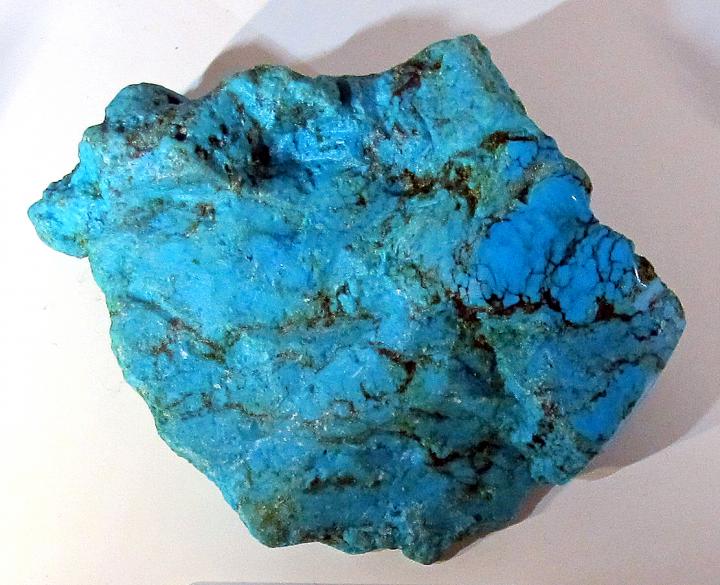December’s birthstone is turquoise, but there are also two alternative birthstones. Turquoise has a deep connection to promoting positive energy; it played a role in Native American beliefs and was even found in the tombs of ancient Egyptians. Learn all about the history, meaning, and symbolism of turquoise, as well as December’s other birthstones, tanzanite and zircon.
Turquoise
Turquoise’s Color
Turquoise occurs in a range of colors: from various shades of green to greenish-yellow to the more recognizable robin egg blue and sky blue. The gem is semi-translucent to opaque and can be found with veins or spider webs, which occur due to the presence of a host of different elements. The veins can appear brown or black.
It can be waxy to the touch and glassy or dull in appearance.
Turquoise Meanings, Symbolism, and Folklore
- The gem has long been thought to possess the powers to ensure good health and fortune. Others believed it could promote happiness, peace, positive energy, protection, and spirituality.
- Hindu mystics believed seeing a turquoise after observing a new Moon would bring wealth.
- Dating back to the 13th century, turquoise was thought to protect those who wore it from falling. It has often been used on horse bridles.
- There was once a belief that the gem would break into multiple pieces when disaster was imminent.
- Turquoise has held significant meaning for Native American tribes. The Apache believed that the gem could be found by following a rainbow to its end, while it could also be used to improve accuracy when attached to a bow or firearm. The Pueblo thought that turquoise received its color from the sky.
- Ancient Egyptians called the gem mefkat, meaning joy and delight.
- According to European tradition, a turquoise ring given as a gift meant “forget me not.”

Where Does Turquoise Come From?
Turquoise is found in dry and barren areas where acidic and copper-rich water seeps into the ground and reacts with phosphorus and aluminum minerals. The result is a compound of hydrated copper and aluminum phosphate. Copper is a factor in the gem’s blue hues, while iron and chrome add a green shade.
The Sinai Peninsula region of Egypt has the oldest turquoise mines. For more than 1,000 years, turquoise has been mined in the Nishapur district of Iran, producing intense blue gems known as “robin’s egg blue,” sky blue,” and “Persian blue.”
Until the early 20th century, New Mexico was the largest producer of turquoise in the United States. Currently, most of the U.S.-produced gems are mined in Arizona and Nevada. China is also a large producer of turquoise.
Turquoise in History
- Turquoise has been a beloved gem for thousands of years and is one of the oldest. In ancient Egypt, pharaohs and other leaders were fond of the gem, often wearing jewelry made with it.
- Chinese artists used turquoise for carvings more than 3,000 years ago.
- Turquoise was used for the funerary mask of King Tut, who ruled ancient Egypt in the 13th century B.C. Some of the world’s oldest jewelry is buried in ancient Egyptian tombs.
- Native American tribes have long used turquoise for ceremonial masks, currency, and jewelry.
- The word turquoise is thought to have stemmed from the French expression “pierre tourques,” referencing the “Turkish stone” brought to Europe from Turkey.
- In addition to being a December birthstone, turquoise is also given for an 11th wedding anniversary.
- Turquoise is the national gem of Tibet.
- It is one of the few minerals whose name also describes its color.
Turquoise in Jewelry
With a Mohs Hardness rating of 5 to 6, some turquoises are treated to improve durability, appearance, and polish. High heat can discolor the gem, while acids can damage it. Use warm, soapy water to clean, and avoid steam or ultrasonic cleaners.
Turquoise is typically cut into cabochons, beads, and flat pieces for inlays, and its soft makeup makes it ideal for carving.
December’s Alternative Birthstones: Tanzanite and Zircon
Turquoise is the gem most associated with those born in the year’s final month, but tanzanite and zircon are also recognized as December birthstones.
Tanzanite
- Tanzanite occurs in a range of blue and violet colors and a combination of the two. Tanzanite, a form of the mineral stone zoisite, often occurs with brownish tones that are then heat treated to produce its deep and saturated blue and violet colors.
- Depending on the viewing angle, tanzanite can show different colors, a process known as pleochroism. Cool lighting will make the blue color more prominent, while warm lighting will emphasize the violet to purple.
- It is one of the newest gems to enter the colored stone world. In 1967, prospectors found the world’s only source for the blue variety of zoisite in the Merelani Hills of northern Tanzania, south of Mount Kilimanjaro. Tanzanite got its name from the country where it is found.
- The gems are found in four mines that extend more than 300 feet below Earth’s surface. A study in 2012 said that deposits could run out within a few decades due to the more than 2 million carats mined annually.
- In addition to being one of the birthstones for December, tanzanite is also given for a 24th wedding anniversary.
- With a Mohs Hardness rating of 6 to 7, tanzanite is best in earrings and pendants and not recommended for rings.
Zircon
- Zircon is found in a wide range of colors—red, orange, yellow, reddish-brown, green, and blue. Colorless zircon, known for its brilliance and flashes of multicolored light, has been confused with the diamond for centuries. It is often heat-treated to produce blue and colorless varieties.
- The coloring of blue zircon will fade after long exposures to direct sunlight, but the color will return after a period of time in a cool, dark place.
- Zircon found in Australia has been said to be the oldest mineral on Earth at 4.4 billion years old.
- In the Middle Ages, zircon was believed to possess the ability to lull someone into a deep sleep. It was also thought to ward off evil spirits, and promote riches and wisdom.
- It was a popular gem in Victorian times and has been found in English estate jewelry dating back to the late 19th century.
- Zircon is not to be confused with cubic zirconia.
- Zircon is found in central Sri Lanka, Australia’s Harts Range, Vietnam, and Cambodia. It is found in the Earth’s crust, as well as in sand, sedimentary deposits, and metamorphic rocks.
- Because of its chemical makeup, including the presence of uranium, zircon has been used to help provide information about Earth’s formation.

Learn More











